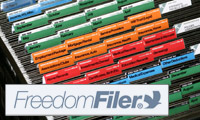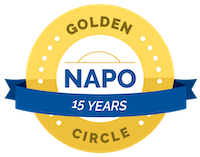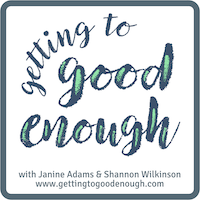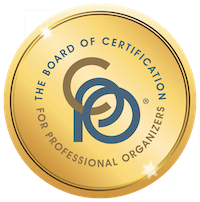Q&A with Courtney Carver, author of Soulful Simplicity
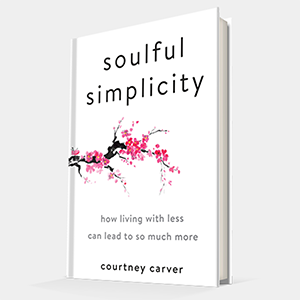
I’ve been a fan of Courtney Carver of Be More With Less since I heard her speak in St. Louis about her Project 333 minimalist clothing challenge. I immediately accepted the challenge and have been enjoying my tiny wardrobe ever since.
Courtney has a new book—out today!—called Soulful Simplicity: How Living with Less Can Lead to So Much More. When her publicist invited me to interview her for a Q&A for this blog I jumped at the chance.
I really enjoyed reading Soulful Simplicity, in which Courtney takes us on her journey toward simplicity, letting go of excess clutter, debt, and responsibilities. She describes the many ways it has benefited her life (including improving her health) and gently guides us to embracing simplicity in our own lives.
I heartily recommend the book for everyone who feels they’re surrounded by too much stuff or overwhelmed by life’s choices or just not living the life they see for themselves. The book inspires, it doesn’t goad. It’s a quick and fulfilling read.

Courtney Carver
Here are some highlights from the enjoyable 45 minutes I spent with Courtney on the phone.
Why did you write this book?
I wrote the book to go deeper than where I’ve gone with the blog. And also because as much as I love hearing from experts and learning from experts, I am much more moved by learning from other messy humans, like myself.
I love that message, but I think of you as an expert!
I definitely don’t consider myself an expert. In fact, I think I’m just learning along with everyone else, and just sharing the experiments and the different things that I’m trying. I’m learning just as much from people who are doing the same thing or doing other things.
I just think it’s so important that we share our stories. I think so often there’s so much of ourselves that we don’t share and so we secretly think that everyone else has it all together and we’re the only people who don’t. On some level, during some time of our life, we’re all a little bit of a mess. And if we share that more openly, it’s less scary to go through. I know I pretended for a long time that I had it all together. And I definitely didn’t.
I think those are wonderful reasons to write a book. I’m curious, when you started your journey, what were some of the biggest surprises that you encountered? Or the things you didn’t expect that happened?
I didn’t really have specific expectations about how things would turn out, so I was really surprised at how much more present I was by letting go of things. I knew of course that by letting go of clutter, there would be more space. That seemed obvious, but that there would be more implied space, more mental space, more heart space, that really surprised me.
How long did that take for you to observe that?
I would say I could notice it, little pieces of it, but when it really set in it was probably a couple of years into it. Because at first you’re really focused on the changes that you’re making and you’re actually adding a little bit to your plate when you’re taking on bigger projects. So it can be a little daunting because you think “I’m really overwhelmed, do I really want to do more to become less overwhelmed?”
As I was reading the book, I was wondering how with your job, and everything going on with your health, you were able to fit in all the changes, including the decluttering and blogging?
I was definitely adding more in, but I was so excited about the changes that I was making and the progress that was happening that it actually lightened things up a little bit. Even for instance, when I started my blog, I was working full time. I didn’t enjoy my job, but working on this other thing, even though it was more hours spent working, I knew it was leading to something that would help me get out of that job. It made me not hate the job as much once I started doing something that I was really interested in.
It probably felt like the beginning of an escape path. Rather than feeling trapped in your job, you were working on something you enjoy that might allow you to let go of your job.
Definitely. Instead of spending that extra time after work complaining and whining about my job or thinking about how much I hated my work, I was actually working on something I cared about.
You started this journey after you were diagnosed with Multiple Sclerosis. The changes you made to your life, including improving your diet, reducing clutter, and eliminating debt actually improved your health and allowed you to live without medicine for MS. Why do you think that is?
I think the biggest thing I would point to is the reduction of stress. Letting go of the stress of the debt and the clutter. And the stress of really fast-paced life. The stress of being someone who I wasn’t. Doing work that was really outside of my heart. That was all very stressful. But when you’re in it, it feels normal. It feels necessary. You convince yourself that it’s up to you to hold all these pieces together no matter what the cost, until you break down to the point where you can’t hold anything together anymore. And then it’s time to rebuild.
Right. That’s a huge message. I think we get caught up in that race, and it feels so necessary, and even desirable for some people, though it perhaps isn’t necessary or desirable at all. But people can get out of it. You created this life for yourself that you’re sharing with us. I think this book would make people who feel trapped feel like there’s a way out for them too. That’s gigantic.
Yeah, when you say desirable, I think you’re right. I think we convince ourselves it’s desirable, because otherwise it’s unbearable.
Those are some powerful words. I think you’re absolutely right. What would you say your favorite aspect of embracing this soulful simplicity is?
That’s easy. My favorite aspect is that I can actually now show up for my life. I can show up for conversations and really be there for the people I love. I can show up for my work and really be there when I’m for instance writing a book or writing a blog post. I have the time and energy to really dive in and stay focused on that one thing. Where prior to really getting rid of a lot of the excess, there was just always too much to be thinking about and dealing with. And so if I was in the middle of a conversation with you, I would probably be also checking my phone, or thinking about my to do list. If I was writing something I would also be checking email and social media, or something like that. I would try to do too much at the same time, which I could kind of gloss over and do that, but I would never be making any real connections. Never be writing anything of substance, and never be really content with my connections to people or projects.
I really believe that we get more freedom when we have less stuff, and you’ve expressed that so well in this book. The book isn’t a how-to, it’s not telling people what they should do. It’s about how you benefited in your life from doing what you did. The way you expressed it is just so clear and so gentle. I love that it’s not directive.
There was more to the interview, of course. I intend to create at least one more blog post from the interview. Stay tuned!
If what Courtney says in this interview resonates with you, please do yourself a favor and read this book. And if you can, go see Courtney talk about the book in person. She’s going on a book tour early next year. (Alas, it doesn’t look like she’ll be coming to St. Louis.) To see if she’s coming to a city near you, check our her book tour page.
Today's piece of holiday advice
Yesterday, I helped a client part with the holiday decor that she didn’t love and wasn’t using. Bags of decor left her storage room to find a new home with folks who will love and use it. She felt great about it (and so did I). When I got home, I wrote down this piece of advice for you.

Should you give the gift of organization?
This time of year I always receive requests for gift certificates. The inquiring person wants to give a session or sessions with an organizer or organizing team. Is this an appropriate gift? It can be.
When I get these requests, I always ask whether the gift will be appreciated. Has the gift recipient ever stated that he or she would like to work with an organizer? If not, there’s a real risk of insulting the recipient—rather like giving an overweight person a Weight Watchers or gym membership.
If I’m assured that the gift is wanted, I gladly provide the gift certificate. But I don’t charge the giver’s credit card until the client calls for the appointment. And over the years, there have been a few times where the call never came.
So if you’d like to give a Peace of Mind Organizing gift certificate, feel free to contact me. I’ll provide you with a pdf of a gift certificate you can print out and give to your loved one. I’ll ask you for a credit card number, but I won’t charge it until the appointment is set.
I’ve had some tremendous success with really motivated clients who were given my services as a gift. But if your gift recipient isn’t interested in help, it can be a less than stellar gift.
Worth repeating: Amazon Prime, the ultimate clutter-free gift
A year ago, I wrote about what a great bargain (and clutter-free gift) Amazon Prime is. For $99 a year, I get not only free two-day shipping, but access to TV shows, movies, digital books, audio books, music, magazines, games and photo storage. I decided to run the post again this year, because I’m still thrilled by Amazon Prime. The benefits from last year remain. In checking it out again this year, I saw that I could borrow a Kindle book and synced audiobook free of charge. I love it! By the way, while I’m working on this blog post, I’m listening, free of charge, to the Hamilton Mixtape on Prime Music.

I’ve been a member of Amazon Prime for years—well over a decade, I’m sure. I first joined when pretty much the only benefit was free two-day shipping (and it cost $79 annually). Now the price is up to $99 but to me it’s an amazing bargain. The free shipping is great. But they have added some benefits that make the $99 expenditure well worth it, even you never have a thing shipped.
I’m a big advocate of giving gifts that won’t create clutter and Amazon Prime fits the bill. (Except, of course, that it would make it easy for the recipient to acquire more physical stuff…but at least that stuff wouldn’t be a hard-to-part-with gift.)
In case you’re not aware, I’ll spell out the Amazon Prime benefits. It provides so many options for accessing information and entertainment, all for $99 a year.
- Free two-day shipping. You not only get your stuff shipped free, it comes more quickly! In certain metropolitan areas, Prime Now offers free same-day delivery is available for certain items.
- Amazon Prime Video. At no additional charge, you can stream certain TV shows (including a library of HBO shows) and movies, as well as Amazon Original programming that is available nowhere else. There are some terrific Amazon Originals, including Transparent, Mozart in the Jungle, The Man in the High Castle, Bosch, and Catastrophe.
- Amazon Prime Music. I recently discovered that I can stream music free of charge and free of ads through Amazon. You can tap into curated playlists or listen to whole albums. I just realized that rather than spending $20 on the Hamilton Original Cast Recording album via iTunes, I could just stream it through Amazon Prime Music. And get this: you can display the lyrics, if you want.
- Audible audiobooks and Audible Channels. Until recently, I didn’t even know that Audible channels existed. I haven’t tried them out yet, but they’re original audio programming that look really interesting. (I’m starting to feel overwhelmed by all the options of things to listen to!) With Amazon Prime, you can stream certain audiobooks and (I think) all Audible Channels at no extra charge.
- Kindle First books*Version*=1&*entries*=0. I’ve written here about how much I love my Amazon Kindle. I read three or four books a month on my Kindle, most of which I check out from the library. Recently, Amazon added Kindle First, which provides Prime Members a monthly small selection of pre-release books, one of which can be downloaded free.
- Kindle Owners Lending Library. With the Kindle Owners Lending Library, Amazon Prime members can borrow one book per month from a limited selection of books. The one caveat is that the borrowed books cannot be read on the Kindle app on other devices; they must be read on the Kindle itself. And you must return the current borrowed book before borrowing another. I’ve taken advantage of this benefit many times.
- Prime Reading. It was only in researching this post that I learned about Prime Reading, which allows free reading of a limited (but not small) selection of books and magazines on your Kindle or Kindle app. What blew me away is that I can read, free of charge, the current issue of certain magazines, including Entertainment Weekly. I subscribed to EW for 25 years before I stopped my subscription because my aging eyes found the type too small to read. I’m taking great joy in knowing that I have access to the current issue (and I can make the type big enough to enjoy!). With a single click, I delivered it to my iPad Mini.
- Prime Photos provides free, unlimited storage space for photos. I haven’t tried it, but if you’re looking for cloud storage for your photos, it might be worth looking into.
- Twitch Prime, for gamers, provides free access to Twitch’s game-streaming service. I don’t even really know what that means, but if you’re a gamer, you might want to check it out.
This isn’t a comprehensive list. For more details, check out the Prime Benefits page at Amazon or this article from CNN, Eight Unknown Perks of Having an Amazon Prime Account.
In the past, you couldn’t give Amazon Prime as a gift. But in 2013 that changed. Click here to purchase Amazon Prime as a gift. You can purchase a year for $99 or three months for $33. Of course, one downside to purchasing a subscription as a gift is that the recipient has to re-up (or you choose to keep giving the gift). If your recipient is using the benefits of Amazon Prime, though, they may be more than happy to renew their subscription.
Put tiny tasks on your to-do list
I don’t know what I’d without a task list. I’d probably go crazy worrying about forgetting to do stuff.
Over the years of honing my own task lists and also working with clients on their task lists, I’ve come to believe in one important truth If you want to create an effective list—and by that I mean a task list that you actually cross items off of—you need to do this:
Break down all your projects and tasks to their smallest components. Add those tiny tasks to your list one by one.
For example, In the past I would sometimes add an item like, “Catch up on Quickbooks” to my daily task list. That task (really, it’s a project) never got crossed off because large tasks like that are:
- so overwhelming I want to avoid it
- not specific enough, so I have to put thought into it before getting started
- too big to do in one sitting
I now add to my list small tasks like, “Enter unentered checks from register into Quickbooks.” Or “enter deposits.” Neither of those tasks takes long or feels overwhelming, so I’m much more likely to do them.
Another example:
Instead of putting “send out holiday cards” on your task list, break that project down into individual tasks, like:
- Select photo for card (or get photo taken)
- Select card
- Add any new addresses to card list
- Order card
- Order stamps
- Write in five cards, etc.
If you break your large tasks or projects down into tiny components, bite by bite you’ll get them done. Bonus: you get the pleasure of crossing off each task as you go. For a task list that feels doable, rather than stressful, always put small tasks on it.
Alternatives to gift wrap

I just left The Container Store. This time of year, their displays feature Gift Wrap Wonderland, where they have rolls upon rolls of beautiful gift wrap. I love The Container Store, truly I do. But as I looked at all that wrap I thought to myself, “Why do people need to spend all this money and storage space just to wrap gifts?”
When I got home, I started thinking about alternatives to purchasing gift wrap. There are so many! This is the list I put together in about two minutes. Can you add anything to it?
- Gift wrap from last year
- Gift bags, rather than wrap (they take up less room and are so easy to re-use)
- One type of wrap, like kraft paper or a solid color. Then you don’t need multiple rolls.
- Newspaper comics, if you subscribe to a newspaper
- Aluminum foil
- Kitchen parchment
- The liner paper from a gift box (my favorite is the illustrated paper that comes inside my monthly Barkbox!)
- Completed pages from coloring books
- Decorated printer paper or newsprint or a former grocery bag
- Kids’ art
- Roadmaps (who uses those to navigate any more?)
- A family tree printed from your genealogy software
- Beautiful wall calendar pages from a previous year
That’s just off the top of my head. If you love spending money and storage space in your home on gift wrap, please don’t let me stop you. But when you get a little creative, you can save money, use your storage space for something else and charm the gift recipient with your creativity.
Photo by Erika G. via Flickr. Used under Creative Commons License.
Worth repeating: Holiday cards the easy way
I wrote this post two years ago. Today I will finish addressing my business’s holiday cards and I used exactly the same method, though I shortened the window by writing in 20 cards per day, rather than 10. I have 70 personal cards to send out, but I have it in hand—there it is below. I’ll get those done in the next week (or less). I love Minted and particularly appreciate their beautiful (and convenient) envelope addressing! It really helps make the process effortless!
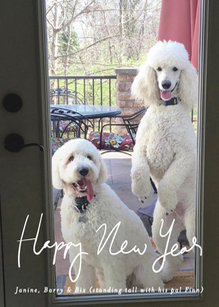
I finished doing my business’s holiday cards this weekend. I send out about 125 cards to clients and colleagues and this year I managed to do it without stress.
In case it helps you make holiday cards easier, I’ll share my process.
- I selected a card flat non-photo New Year’s card from Minted.com and customized it with my business’s name. I put a printed backer on it, but no text. (I like New Year’s cards because they’re secular and they give me a little extra time, though I didn’t need it this year.) I also included a complementary Skinnywrap return address label.
- I uploaded a spreadsheet of the recipient’s names and addresses to the Address Assistant in my account on Minted. (I did have to use an app called Export Address Book to export from the Contacts app on my Mac.) Minted will print the names and addresses on the envelopes free of charge this year.
- When the cards arrived, I put the cards, envelopes, Skinnywrap labels, Sharpies and stamps in a container so everything would be together when I wanted to work on cards.
- Every day, I wrote a message on the back of ten cards, sealed them, affixed stamps and affixed the return address labels.
It took me a couple of weeks, but they’re all done and now all I have to do is put them in the mail!
Doing just ten at a time made this task so easy. And the fact that I didn’t have to hand address or print and affix address labels made a big difference, too.
If you use a Mac and would like guidance on printing labels directly from your Mac’s Contacts app (which is what I used to do before letting Minted do my addressing for me), this video from Ruth Davis of Mac2School shows you how.
The good news is that my professional cards are done. The bad news is that I still have about 75 personal cards to send out, but I have to wait until our puppy arrives on December 13 (squee!) so the card can sport a picture of him. But I’ve done what I can by uploading the addresses spreadsheet to Minted. Next steps will be get a great photo of the puppy, upload it to Minted and order my cards. Then I’ll do 10 at a time again. I should have it all done before Christmas but, if not, before January 1. I love that it feels so easy.
Links
- Ravelry
- Shannon Wilkinson, life coach
- National Association of Productivity and Organizing Professionals
- Peace of Mind Budgeting
- Organize Your Family History
- NAPO St. Louis
- Institute for Challenging Disorganization
- Are you interested in becoming a professional organizer?
- Getting to Good Enough podcast

